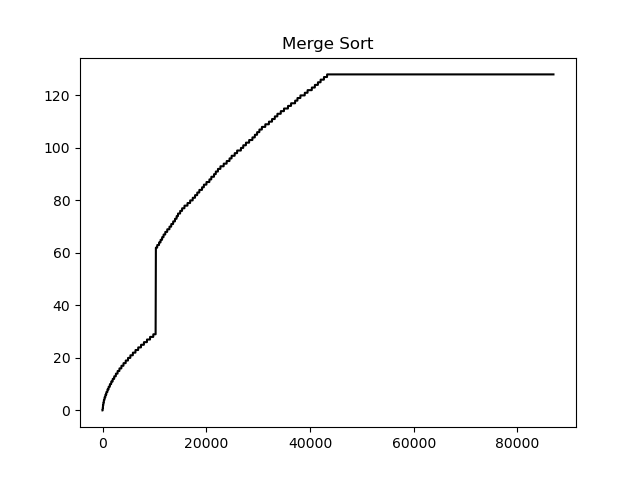os-virtual-mem-emulator
A simulation of the virtual memory. Page replacement and allocation algorithms are compared by the number of:
- Reads
- Writes
- Page replacements
- Disk page writes
- Disk page reads
sortArrays frameSize numPhysical numVirtual pageReplacement allocPolicy pageTablePrintInt diskFileName.dat
frameSize is the size of the page frames, numPhysical is the total number of page frames in the physical memory,
numVirtual is the total number of frames in the virtual address space, pageReplacement is the page replacement algorithm
(NRU, FIFO, SC, LRU, WSClock), allocPolicy is the allocation policy (global or local), pageTablePrintInt is the interval of memory accesses after which the page table is printed on screen, diskFileName.dat is the name of the file that keeps the out of memory frames.
For example,
sortArrays 12 5 10 LRU local 10000 diskFileName.dat
defines a frame size of 2 12 (4096) integers, 2 5 (32) physical frames, 2 10 (1024) virtual frames, uses LRU as page replacement
algorithm, local allocation policy, and diskFileName.dat as the disk file name. In other words, this system has a physical
memory that can hold 4096*32=131.072 integers and has a virtual memory that can hold 4096*1024= 4.194.304 integers. This
command prints the page table on the screen at every 10000 memory accesses.
Benchmark parameters are like this:
./benchmark phyIntCount
phyIntCount is the number of integers in the physical memory in terms of 2's power.
For example:
if phyIntCount = 14 then for framSize = 1, numPhysical will be 13. (also numVirtual is always set to numPhysical + 4)
phyIntCount = 14 is the parameter required for sorting 16K integers in physical memory and 128K integers in virtual memory.
Building
make
Results and Evaluation
Some stats to compare the algorithms.
 Here index sort causes many misses because index sort changes the target array elements only when the sorted position of each index is known thus the number of writes required would be minimal. re very high because locality principles do not apply strongly in the first phase of the algorithm. In the second phase even though the number of writes is minimum, very high are done to unrelated places because the initial array given is unsorted. Even though bubble sort has 100 times more number of writes the close to each other with index sort. Index sort is maybe more useful when the target array elements are big data structures.
Here index sort causes many misses because index sort changes the target array elements only when the sorted position of each index is known thus the number of writes required would be minimal. re very high because locality principles do not apply strongly in the first phase of the algorithm. In the second phase even though the number of writes is minimum, very high are done to unrelated places because the initial array given is unsorted. Even though bubble sort has 100 times more number of writes the close to each other with index sort. Index sort is maybe more useful when the target array elements are big data structures.
Let w(k,t) the working set be the set of pages used by an application in the most recent k references at time t. We can plot the appoximate working set graph with our utilities when t is fixed to the finishing moment of the application.
Here is an example for Merge Sort thread.

The sudden increase in the number of pages is probably because quicksort thread finished early and the remaining pages was given to merge sort thread.
Benchmark results from various experiments.
Bubble Sort
Optimal Frame Size is 4
| Read Count | Write Count | Page Misses | Page Replacement | Disk Reads | Disk Writes |
|---|---|---|---|---|---|
| 65251 | 36982 | 5693 | 5693 | 5693 | 1671 |
Optimal Replacement Algorithm is LRU
| Read Count | Write Count | Page Misses | Page Replacement | Disk Reads | Disk Writes |
|---|---|---|---|---|---|
| 65251 | 36982 | 9029 | 9024 | 9029 | 2197 |
Quick Sort
Optimal Frame Size is 4
| Read Count | Write Count | Page Misses | Page Replacement | Disk Reads | Disk Writes |
|---|---|---|---|---|---|
| 4678 | 2230 | 638 | 636 | 638 | 311 |
Optimal Replacement Algorithm is LRU
| Read Count | Write Count | Page Misses | Page Replacement | Disk Reads | Disk Writes |
|---|---|---|---|---|---|
| 4678 | 2230 | 577 | 574 | 577 | 244 |
Merge Sort
Optimal Frame Size is 4
| Read Count | Write Count | Page Misses | Page Replacement | Disk Reads | Disk Writes |
|---|---|---|---|---|---|
| 21337 | 17585 | 2394 | 2394 | 2394 | 1113 |
Optimal Replacement Algorithm is LRU
| Read Count | Write Count | Page Misses | Page Replacement | Disk Reads | Disk Writes |
|---|---|---|---|---|---|
| 21337 | 17585 | 3879 | 3877 | 3879 | 1385 |
Index Sort
Optimal Frame Size is 3
| Read Count | Write Count | Page Misses | Page Replacement | Disk Reads | Disk Writes |
|---|---|---|---|---|---|
| 132020 | 948 | 54445 | 54442 | 54445 | 4565 |
Optimal Replacement Algorithm is LRU
| Read Count | Write Count | Page Misses | Page Replacement | Disk Reads | Disk Writes |
|---|---|---|---|---|---|
| 132020 | 948 | 44718 | 44714 | 44718 | 8597 |